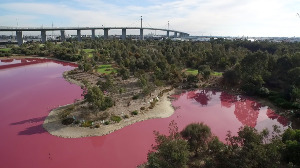
Have you ever seen a pink lake? There is a lake at a park in Melbourne, Australia that turns hot-pink every year. It turns pink because the lake contains salt-loving, single-celled germs that make pigments called
carotenoids
.
Carotenoids are a class of plant chemicals found in the cells of a large variety of plants, algae, and bacteria. Carotenoids are responsible for the bright red, yellow, and orange shades of many fruits and vegetables. For example, carotenoids are found in oranges, bell peppers, tomatoes, spinach, mangoes, watermelons, yams, and—of course—carrots. These pigments play a very important role for plant health; specifically, carotenoids help plants absorb light energy to use in photosynthesis.
By eating foods containing carotenoids, people can also get health benefits. For example, carotenoids are sometimes associated with the prevention of cardiovascular disease. They also benefit the immune system, act as antioxidants in the human body, and have strong cancer-fighting properties. Some carotenoids are converted to Vitamin A by the body: Vitamin A is important for vision, growth, and development.
The Melbourne lake turns pink when the weather gets warm and dry. The lake probably receives sea salt underground from a nearby bay or river. When water evaporates from the saltwater lake, its
salinity
, or saltyness, increases eight to ten times that of an ocean's. Since the lake's salt concentration is incredibly high, a type of single-celled algae starts producing carotenoids, which then gives the lake a pink color. The carotenoids also act as a filter to protect the lake algae’s chlorophyll.
Salt lakes can turn pink only when the right factors combine. Other pink-turning lakes in Australia include one in Murray-Sunset National Park, one near the town of Dimboola, and another in Western Australia. Pink or red lakes exist in other countries too, including Spain, Senegal, the Crimean Peninsula, Azerbaijan, Tanzania, Bolivia, Kenya, and Mexico.
[Sources:
The New York Times
;
Live Science
]

